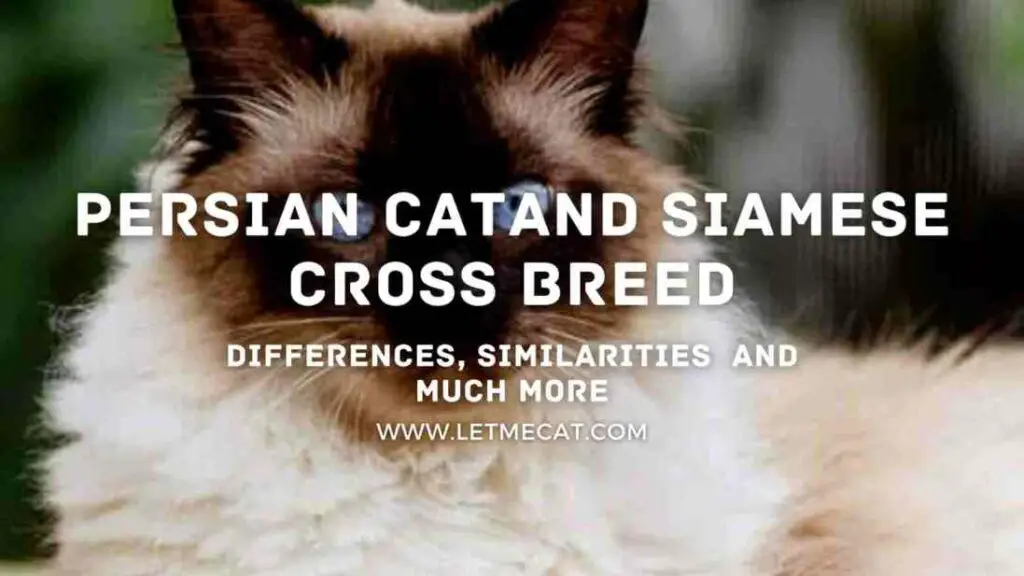Himalayans or Himmies are fascinating and unique crossbreeds of Persian cats and Siamese cats that have grown in popularity among cat lovers. These cats inherit characteristics from both of their parent breeds, resulting in a stunning mix of physical and personality traits.
Crossbreeds of Persian cats and Siamese cats are a sight to behold, with their striking color points and long hair, as well as their playful and affectionate nature.
To give you a better understanding of these beloved feline companions, we will look at the history and characteristics of both parent breeds, as well as the similarities and differences of the crossbreed.
Persian Cat Breed
Overview of the Persian Cat Breed and its History
The Persian Cat is one of the world’s oldest breeds, dating back to ancient Persia (modern-day Iran).
The wealthy elite kept these cats as status symbols because they were highly valued for their beauty. The Persian Cat eventually made its way to Europe, where it became a popular pet in the 17th century.
The Persian Cat’s distinguishing characteristics, such as its long, fluffy coat and round face, were selectively bred for, resulting in the modern Persian Cat we know today.
Persian cats are known for their calm, affectionate temperament and preference for quiet, peaceful surroundings. They are frequently referred to as “lap cats” because they enjoy being pampered by their owners.
The breed, however, is prone to some health issues, such as respiratory issues, and requires regular grooming to keep its coat healthy and free of mats.
Despite these challenges, Persian Cats are a popular breed among cat lovers and are frequently featured in shows and competitions around the world.
Physical Characteristics and Personality Traits of Persian Cats
1. Physical Characteristics
The Persian Cat is a medium-to-large breed with a distinct round face, small ears, and a long, fluffy coat in a variety of colors and patterns.
Their eyes are big and expressive, and they can be blue, green, or gold. The breed has a strong, muscular build and a broad chest, giving it a regal and elegant appearance.
Their coat is soft and must be groomed daily to prevent matting and tangling.
2. Personality Traits
Persian cats come with the below-listed personality traits:
- Persian cats are known for being gentle, calm, and affectionate.
- They prefer a quiet and peaceful environment and enjoy being around their owners.
- They are not very active and would rather spend their time lounging or napping.
- Persian cats are not particularly vocal but have been observed communicating through their eyes and body language.
- They are also extremely sensitive to their owner’s moods and can become agitated if their surroundings are too chaotic or noisy.
- Persian Cats are not typically recommended for households with young children or other active pets due to their passive nature.
Overall, the Persian Cat is a devoted and loving companion who would make an excellent addition to any family that can provide them with the quiet and relaxing environment they require.
Common health issues and how to care for a Persian Cat
1. Common Health Issues
The Persian Cat, like all breeds, is prone to certain health issues that owners should be aware of. Because of their flat face and shortened snouts, one of the most common health issues is respiratory problems. This can make breathing difficult and lead to snoring, sneezing, and other respiratory problems.
Persian Cats are also prone to dental issues such as tooth decay and gum disease. Kidney disease, polycystic kidney disease, and liver shunts are some of the other health issues that can affect the breed.
2. Care Requirements
There are several care requirements that you should be aware of in order to keep your Persian cat healthy.
To begin, regular grooming is required to keep their long, fluffy coat healthy and free of mats. This includes:
- Brushing their fur daily
- Giving them baths on occasion to keep them clean and tangle-free
Furthermore, regular dental checkups and cleanings are essential for preventing tooth decay and gum disease.
Owners should also be aware of their cat’s diet and ensure that it is receiving adequate nutrition in order to maintain overall health.
Finally, it is critical to provide a calm and peaceful environment for your Persian Cat in order to avoid stress and anxiety, which can exacerbate respiratory issues.
You can help your Persian Cat live a happy and healthy life by following these care requirements and providing regular veterinary checkups.
Benefits and drawbacks of owning a Persian Cat
1. Benefits
The experience of owning a Persian Cat can be rewarding and enjoyable. One of the most significant advantages of owning a Persian Cat is its affectionate and gentle nature.
They enjoy being petted and pampered and enjoy spending time with their owners. They also have a quiet and peaceful demeanor, making them excellent companions for those seeking a relaxed and calm pet. Their long, fluffy coats and round faces are also endearing, making them a favorite among cat lovers.
Finally, despite their passive nature, they can be entertaining to watch when they are playful.
2. Drawbacks
While owning a Persian Cat can be rewarding, there are some disadvantages to be aware of. One of the most significant disadvantages is the need for grooming. Their long, fluffy coats necessitate daily grooming to avoid matting and tangling, which can be time-consuming and labor-intensive.
Furthermore, their flat faces can cause respiratory problems, resulting in snoring, sneezing, and other issues. The breed is also predisposed to dental issues, which can be costly to treat.
Finally, because they prefer a quiet and peaceful environment, they are not suitable for households with young children or other active pets.
Siamese Cat Breed
Overview of the Siamese Cat breed and its History
1. Overview
Overview of the Siamese cat breed includes:
- The Siamese Cat is a distinct breed distinguished by its striking appearance and playful, vocal personality.
- Their body is sleek and muscular, with long, slender legs and a wedge-shaped head with large, pointed ears.
- Their coat is short and fine, with a darker color pattern on their ears, tail, and legs.
- Siamese cats are known for their vocal nature, and will frequently meow or “talk” to their owners in order to get their attention.
- They are also very social and enjoy interacting with their owners as well as other pets.
2. History
The Siamese Cat has a fascinating history dating back centuries. They are thought to have originated in Siam (now Thailand), where royalty and Buddhist monks kept them as treasured pets. They were revered and frequently featured in religious ceremonies.
Siamese cats were introduced to England in the late 1800s and quickly became popular among cat lovers. The breed was then introduced to the United States, where it quickly became one of the most popular breeds.
Today, the Siamese Cat is regarded as one of the world’s most distinctive and adored breeds. They are popular among cat lovers of all ages due to their playful nature and striking appearance.
Physical Characteristics and Personality Traits of Siamese Cats
1. Physical Characteristics
Some physical characteristics of Siamese cats are:
- The Siamese Cat is a lean, muscular breed with a wedge-shaped head and long, slender legs.
- They have large, pointed ears as well as almond-shaped blue eyes set deep in their heads.
- Their coat is short and fine, with a darker color pattern on their ears, tail, and legs.
- Seal, chocolate, blue, and lilac are some of the colors available for Siamese Cats.
- They’re a medium-sized breed, with males weighing 8-12 pounds and females weighing 6-8 pounds.
2. Personality Traits
Some personality traits of Simaese cat breeds are:
- Siamese cats are known for being outgoing and affectionate.
- They are extremely intelligent and enjoy interacting with their owners, frequently following them around the house and meowing for attention.
- They are also very vocal, frequently “talking” to their owners in a variety of meows and sounds.
- Siamese cats are social and enjoy other pets’ company, making them an excellent choice for multi-pet households.
- They are also energetic and playful, and they enjoy toys and games that test their intelligence and agility.
- Siamese cats are devoted to their owners and form strong bonds that can last a lifetime.
Overall, they are a popular breed among cat lovers of all ages due to their friendly and engaging personalities.
Common health issues and how to care for a Siamese Cat
1. Common Health Issues
Siamese cats are generally healthy and live for 10 to 12 years. They are, however, susceptible to certain health issues, as are all breeds.
Dental problems, such as gum disease and tooth decay, are among the most common health issues in Siamese Cats. This can be avoided by getting regular dental cleanings and practicing good oral hygiene.
Siamese cats are also prone to respiratory issues like asthma and bronchitis, which can be exacerbated by smoke or other irritants. They may also be predisposed to certain genetic disorders, such as amyloidosis and progressive retinal atrophy.
2. Caring for a Siamese Cat
It is critical to provide a healthy and balanced diet that meets the nutritional needs of a Siamese Cat. They also require daily grooming to keep their short, fine coat in good condition and to avoid hairballs.
Regular veterinary check-ups are essential for detecting any health issues and ensuring their overall health and well-being.
Dental cleanings should also be done on a regular basis to avoid dental problems.
Siamese cats are social and enjoy the company of their owners and other pets, so they require a lot of attention and socialization. They are also active and playful, necessitating regular exercise and mental stimulation.
Overall, Siamese Cats can live long, healthy, and happy lives with proper care and attention.
Benefits and drawbacks of owning a Siamese Cat
1. Benefits
Some benefits of owning a Siamese cat include:
- Siamese cats are a distinct and popular breed among cat owners due to their striking blue eyes, distinct markings, and playful personalities.
- They are well-known for their outgoing and vocal personalities, making them ideal pets for those who enjoy interacting with their animals.
- Siamese cats are also extremely intelligent and trainable, making them ideal for leash training, tricks, and other forms of mental stimulation.
- They are also very social and enjoy spending time with their owners and other pets, making them ideal for families with children or other animals.
- They are also generally healthy and have a long lifespan of 10-12 years.
2. Drawbacks
One of the most significant disadvantages of owning a Siamese Cat is its vocal nature. They are well-known for their loud meows and proclivity to “talk” to their owners, which can be disruptive and irritating to some.
They can also be quite demanding, necessitating a great deal of attention and stimulation in order to prevent destructive behaviors.
Siamese Cats are also susceptible to certain health issues, such as dental problems, respiratory problems, and genetic disorders, which necessitate regular veterinary care and monitoring.
They also have a high level of energy and require daily exercise and playtime to avoid boredom and anxiety.
Differences and Similarities between Persian Cat and Siamese Cross Breed
1. Differences
Here are some specific differences between the Persian cat and the Siamese crossbreed:
Appearance
Crossbreeds can have physical characteristics from both breeds, with some having longer, thicker fur like the Persian and others having shorter, finer fur like the Siamese. They may also have a more moderate facial structure than the Persian, with a less flat face or a less pronounced wedge shape than the Siamese.
Personality
Depending on the genetic makeup of the individual cat, crossbreeds can have a variety of personalities. Some people are more laid-back and independent, while others are more active and demand attention. They can be loving, social, and intelligent cats who enjoy playing and interacting with their owners.
Health Issues
Crossbreeds are susceptible to some of the same health issues as purebreds, such as dental problems, obesity, and respiratory problems. They may, however, be at a lower risk of some breed-specific health issues, such as polycystic kidney disease (PKD) in Persian cats and hyperthyroidism in Siamese cats.
Grooming Requirements
Depending on the type of fur, crossbreeds may require varying levels of grooming. Longer, thicker fur may necessitate more frequent brushing and grooming to prevent matting and hairballs, whereas shorter fur may necessitate less maintenance.
Activity Level
Depending on their individual personalities and genetic makeup, crossbreeds may have a moderate to high activity level. Some people are more active and playful, while others prefer to sit back and relax.
2. Similarities
Here are some specific similarities between the Persian cat and Siamese cross breed:
Intelligence
Persian and Siamese cats are both known for their intelligence, and crossbreeds can inherit this trait as well. They can be taught tricks and enjoy interactive toys and puzzles.
Affectionate
Persian-Siamese cat crossbreeds are generally very affectionate and social animals. They crave attention and enjoy spending time with their human family members.
Playful
These crossbreeds can be extremely playful and active, with a penchant for toys and games. They are inquisitive and enjoy exploring their surroundings.
Indoor Cats
Persian and Siamese cats, as well as their crossbreeds, are best suited as indoor cats due to their physical characteristics and temperament.
Low-maintenance Exercise
Although crossbreeds can be active and playful, they do not require a lot of high-intensity exercises. Short periods of play and access to climbing structures can help them stay healthy and happy.
Moderate Vocalization
While Siamese cats are known for their vocalization, crossbreeds may have a more moderate level of vocalization because they are a mix of both breeds.
FAQs
Q1. What is a crossbreed of a Persian sat and a Siamese cat called?
Q2. What is the temperament of a crossbreed of a Persian cat and a Siamese cat?
Q3. Do crossbreeds of Persian cats and Siamese cats shed a lot?
Q4. Are crossbreeds of Persian cats and Siamese cats good with children?
Q5. What are some common health issues that crossbreeds of Persian cats and Siamese cats can face?
Q6. Do crossbreeds of Persian cats and Siamese cats need a lot of grooming?
Q7. Can crossbreeds of Persian cats and Siamese cats live in small apartments?
Conclusion
In conclusion, the Persian cat and Siamese cross breed have a lot to offer. These cats are friendly, intelligent, and endearingly beautiful. Their personalities are a delightful blend of the fiery Siamese and the more laid-back Persian. Hybrid cats, with proper care and diet, can be very healthy as well. Having one of these endearing creatures as a pet can be a very rewarding experience for any cat lover.
Do feel free to share this article with other cat lovers if you have found it helpful. Thank you for reading it.




This post helps me very much. Thanks for this helpful content.
Thank you.
Pingback: Can Male Persian Cat Mate With Female Siamese Cat? Answered - Let Me Cat
Pingback: [Why] Siamese/Persian Mix Cats Coveted Among Breeders? - Let Me Cat